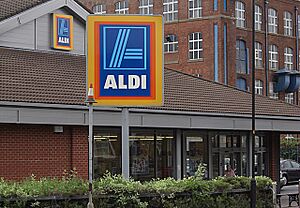Shaw, Greater Manchester facts for kids
Quick facts for kids Shaw |
|
|---|---|
 Aldi, Shaw |
|
| Area | 4.025 km2 (1.554 sq mi) |
| Population | 18,245 (2021 census) |
| • Density | 4,533/km2 (11,740/sq mi) |
| Civil parish | |
| Metropolitan borough | |
| Metropolitan county | |
| Region | |
| Country | England |
| Sovereign state | United Kingdom |
| Post town | Oldham |
| Postcode district | OL2 |
| Dialling code | 0161 |
| Police | Greater Manchester |
| Fire | Greater Manchester |
| Ambulance | North West |
| EU Parliament | North West England |
Shaw is a lively town located in Greater Manchester, England. It is part of a larger area called Shaw and Crompton. Shaw is found within the Oldham district. This town is about 9 miles (14.5 km) away from the busy Manchester city centre.
In 2021, the whole area of Shaw and Crompton had about 18,245 people living there. The specific part known as the Shaw ward had a population of 10,045 people. Before 1974, Shaw was part of the historic county of Lancashire.
Discovering Shaw's Past
What Does the Name "Shaw" Mean?
The name "Shaw" has a cool history! It comes from an old English word, sceaga. This word means "copse" or "small wood". A copse is like a small group of trees or a mini-forest.
The name "Shaghe" was first written down in records way back in the year 1555. This tells us that the area likely had many small woods or tree groups a long time ago.
See also
 In Spanish: Shaw y Crompton para niños
In Spanish: Shaw y Crompton para niños


